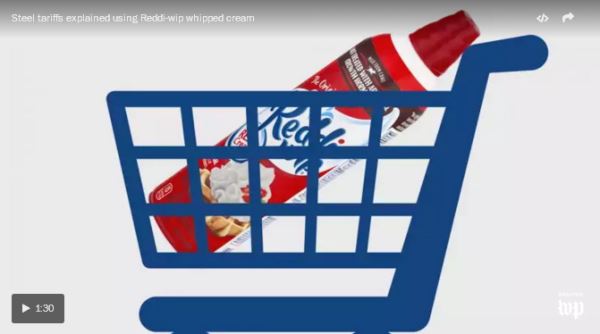The United States and China dug in for a protracted trade war Friday, with the Chinese government saying it would “fight at any cost” President Trump’s threat to slap new tariffs on $100 billion in Chinese goods.
While the White House offered a slim hint Friday that it would be prepared to negotiate an end to the deepening standoff, Treasury Secretary Steven Mnuchin also acknowledged “the potential of a trade war.” His remarks on CNBC spurred fears of an open brawl between the world’s two largest economies and immediately sent the Dow Jones industrial average plummeting 767 points.
Mnuchin added he was “cautiously optimistic” that the two sides would be able to reach an agreement. “Our objective is still not to be in a trade war,” Mnuchin said.
The Dow recovered somewhat and ended the day down 572 points, a loss of about 2.3 percent.
Trump announced that he was considering expanded tariffs Thursday night, hours after administration officials played down the idea of a trade war. On Friday morning, China’s Commerce Ministry told reporters that it would retaliate if the new tariffs were imposed, saying, “China has very detailed countermeasures.”
Around midday in Asia, the Commerce Ministry released a terse statement: “On the issue of Sino-U.S. trade, the Chinese position has been made very clear. We do not want to fight, but we are not afraid to fight a trade war.”

China has not been alone in raising alarm about Trump’s trade threats. American business groups and some GOP lawmakers have harshly criticized the president for escalating matters with Beijing.
The Information Technology Industry Council called the new threat of tariffs “irresponsible and destabilizing,” while the National Retail Federation warned that the two nations were on a “dangerous downward spiral” that could “spell disaster for the U.S. economy.” In response to Trump’s tariff announcement Thursday night, Sen. Ben Sasse (R-Neb.) said: “This is nuts.”
In a sign that the White House could be prepared to de-escalate the trade conflict, Larry Kudlow, director of the White House’s National Economic Council, said Friday that Trump was open to the idea of presenting Chinese leader Xi Jinping a list of requirements that would include the removal of certain tariffs on American-made goods.
“You might see the United States may provide a list of suggestions to China as to what we would like to see come out of this,” Kudlow told reporters, adding that no decision has been made so far.
But Kudlow also said that Trump would continue standing up to Beijing and escalating matters if necessary.

“What this is is an attempt by a strong-willed, strong-backboned president to right some wrongs . . . with respect to China,” Kudlow said.
Before joining the White House, Kudlow, as a CNBC commentator, was critical of Trump’s threats to impose tariffs on steel and aluminum imports, warning that they could harm the U.S. economy. But he told reporters Friday that they are necessary to force Beijing to eliminate trade barriers and allow more U.S. products into China.
“I’m not a tariff guy,” Kudlow said. “I don’t like to use them, but sometimes you have to use tariffs to bring countries to their senses.”
The threats have spooked financial markets, in part because the Trump administration has given different explanations for what the president is trying to do. Kudlow, who is in his first week on the job as Trump’s chief economic adviser, has tried to exude calm, while Trump has continued to blast China in public statements and social media posts.
The stakes for the U.S. consumer, as well as the global economy, are immense. If the United States and China slap large tariffs on each other’s exports, it could drive up costs for consumers, lead to a contraction in spending and arrest growth. Millions of American households are full of Chinese exports, including electronics, clothing and appliances. If costs on these products go up, even incrementally, it could lead to a chain reaction in the global economy — with uncertain consequences. Trump is wagering that Beijing will flinch and back down, but so far, Chinese leaders have shown no sign of retreating.
The trade confrontation with China got underway in March, representing a second-year shift in the president’s stewardship of the economy from a more traditional Republican Party line to the “America First” populism Trump embraced as a candidate.
The new agenda was reflected in recent changes in White House staffing. Gary Cohn, the first chief of Trump’s economic council and an ardent free-trader, resigned after Trump unleashed the first wave of tariffs on March 8 against imported steel and aluminum. (Rob Porter, another aide and free-trade supporter, left the White House after it was revealed that his ex-wives had accused him of physical and emotional abuse.)
Meanwhile, White House adviser Peter Navarro, a longtime China critic, has seen his internal stature rise as he encouraged Trump to follow his protectionist instincts.
Trump in 2017 largely kept to the economic orthodoxy of the GOP, overseeing legislation that delivered huge, corporate-friendly tax cuts that Republicans have pursued for decades — a measure that included repeal of a critical provision of President Barack Obama’s Affordable Care Act. The Trump administration also rolled back Obama-era regulations, pausing or scrapping rules on the climate and labor.
In words and on Twitter, Trump continued to espouse the anti-free-trade rhetoric of his campaign, but he typically pulled back before making major moves. He stopped short of labeling China a “currency manipulator,” despite a campaign promise, and he opted to renegotiate the North American Free Trade Agreement after a last-minute push from lawmakers and Cabinet officials persuaded him not to pull out of the pact.
But that changed in 2018, as Trump pursued a new set of protectionist policies despite protests from Republican lawmakers and businesses who supported him during the tax debate.
“The one thing Trump’s been consistent on for four decades is he does not believe in free trade. At heart, he is a protectionist,” said Joe Brusuelas, chief economist at accounting firm RSM.
The pivot has frayed Trump’s relationships with fellow Republicans, who have publicly criticized his tariffs and continue to privately lobby his administration to water them down.
The course change to a more protectionist agenda manifested in early March with the steel and aluminum tariffs. Trump alleged that a range of allies and rivals were flooding the United States with cheap metals in a way that harmed U.S. workers. He has since exempted most major steel and aluminum producers from these tariffs, except for China.
In response, China listed 128 items on which it planned to impose tariffs, including pork and a range of agricultural products. Then Trump pledged new tariffs against China, prompting Beijing to threaten even broader tariffs against U.S. exports such as cars.
This led Trump on Thursday evening to issue a statement saying that he is considering additional tariffs on $100 billion in Chinese imports, which would represent 20 percent of the items China sells the United States each year.
China exports far more to the United States than it imports, a fact that Trump has said is due to Beijing’s improper economic practices. China has often disputed this, but other countries have also complained that China should do more to open its markets and stop subsidizing key industries in a way that gives the country an unfair advantage.
Other nations, though, have preferred a multinational approach in confronting Beijing, something Trump has said he does not believe works. His adversarial tactics this year have confused world leaders but also sent a signal that the U.S. approach to China has changed markedly.
Luna Lin in Beijing and Josh Dawsey contributed to this report.
(The Washington Post)